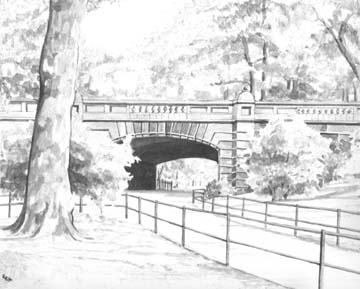Along the Drive not far from the entrance at the equestrian statue of General Sherman, a little over 100 feet of stone balustrading in comparatively undamaged condition identifies the Green Gap Arch below. A walkway under the Drive comes from the Zoo and goes west. Originally it was part of the bridle path under the arch, permitting entry and exit at the Scholar's Gate, Fifth Avenue and 60th Street.
With an underpass 81 feet long, it has a shallow segmental span, 25 feet wide and 13 feet 3 inches high. The facing of Alberta sandstone, from the quarry in New Brunswick, is set in ashlar that continues the outlines of the voussoirs. Posts of the parapet continue downward as supporting piers of the abutments which have, in part, been concealed by the soil of the planted slopes. For the stonework of this archway, Jacob Wrey Mould, assisting Calvert Vaux, made drawings of the details that were then sent to the contracting stoneyards to be cut and shaped to specification. These drawings are in the Municipal Archives.
The attention to detail is seen in the ashlar of sandstone. In addition to being rusticated, the voussoirs are alternately smooth and roughly bush-hammered. The sidewalls are part balustrade and part parapet wall with posts, at the piers, topped by bosses.
The report of the Treasurer of the Board of Commissioners of the Central Park, published in 1861, listing disbursements made the preceding year, names Stewart & Howell as contractors.
Green Gap Arch is another of the large drive-carrying arches, originally serving the bridle path to find its way to Scholar's Gate. The balustrades adjacent to the heavily trafficked drive suffered some deterioration-over time, but the original stonework is substantially intact. The severe decay once evident in the soft, highly permeable sandstone was repaired in 1988 when the bridge was made part of the Central Park Zoo. With the Zoo's reconstruction, Green Gap Arch now serves as the westerly entrance from within the park.

Original ink and watercolor drawing. 1859.
Municipal Archives.




